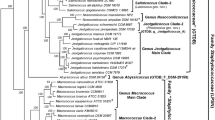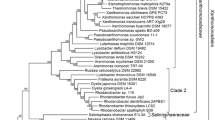Abstract
The members of the order Pasteurellales are currently distinguished primarily on the basis of their branching in the rRNA trees and no convincing biochemical or molecular markers are known that distinguish them from all other bacteria. The genome sequences for 20 Pasteurellaceae species/strains are now publicly available. We report here detailed analyses of protein sequences from these genomes to identify conserved signature indels (CSIs) that are specific for either all Pasteurellales or its major clades. We describe more than 23 CSIs in widely distributed genes/proteins that are uniquely shared by all sequenced Pasteurellaceae species/strains but are not found in any other bacteria. Twenty-one additional CSIs are also specific for the Pasteurellales except in some of these cases homologues were not detected in a few species or the CSI was also present in an isolated non-Pasteurellaceae species. The sequenced Pasteurellaceae species formed two distinct clades in a phylogenetic tree based upon concatenated sequences for 10 conserved proteins. The first of these clades consisting of Aggregatibacter, Pasteurella, Actinobacillus succinogenes, Mannheimia succiniciproducens, Haemophilus influenzae and Haemophilus somnus was also independently supported by 13 uniquely shared CSIs that are not present in other Pasteurellaceae species or other bacteria. Another clade consisting of the remaining Pasteurellaceae species (viz. Actinobacillus pleuropneumoniae, Actinobacillus minor, Haemophilus ducryi, Mannheimia haemolytica and Haemophilus parasuis) was also strongly and independently supported by nine CSIs that are uniquely present in these bacteria. The order Pasteurellales is presently made up of a single family, Pasteurellaceae, that encompasses all of its genera. In this context, our identification of two distinct clades within the Pasteurellales, which are supported by both phylogenetic analyses and by multiple highly specific molecular markers, strongly argues for and provides potential means for the division of various genera from this order into a minimum of two families. The genetic changes responsible for these CSIs were likely introduced in the common ancestors of either all Pasteurellales or of these two specific clades. These CSIs provide novel means for the identification and circumscription of these groups of Pasteurellales in molecular terms.






Similar content being viewed by others
References
Barabote RD, Xie G, Leu DH et al (2009) Complete genome of the cellulolytic thermophile Acidothermus cellulolyticus 11B provides insights into its ecophysiological and evolutionary adaptations. Genome Res 19:1033–1043
Bisgaard M (1993) Ecology and significance of Pasteurellaceae in animals. Zentralbl Bakteriol 279:7–26
Bonaventura MP, Lee EK, DeSalle R, Planet PJ (2010) A whole-genome phylogeny of the family Pasteurellaceae. Mol Phylogenet Evol 54:950–956
Bosse JT, Janson H, Sheehan BJ et al (2002) Actinobacillus pleuropneumoniae: pathobiology and pathogenesis of infection. Microbes Infect 4:225–235
Castresana J (2000) Selection of conserved blocks from multiple alignments for their use in phylogenetic analysis. Mol Biol Evol 17:540–552
Chen C, Kittichotirat W, Si Y, Bumgarner R (2009) Genome sequence of Aggregatibacter actinomycetemcomitans serotype c strain D11S-1. J Bacteriol 191:7378–7379
Christensen H, Bisgaard M (2006) The genus Pasteurella. In: Dworkin M (ed) The prokaryotes: a handbook on the biology of bacteria. New York, Springer, pp 1062–1090
Christensen H, Bisgaard M (2010) Molecular classification and its impact on diagnostics and understanding the phylogeny and epidemiology of selected members of Pasteurellaceae of veterinary importance. Berl Munch Tierarztl Wochenschr 123:20–30
Christensen H, Kuhnert P, Olsen JE, Bisgaard M (2004) Comparative phylogenies of the housekeeping genes atpD, infB and rpoB and the 16S rRNA gene within the Pasteurellaceae. Int J Syst Evol Microbiol 54:1601–1609
Christensen H, Kuhnert P, Busse HJ, Frederiksen WC, Bisgaard M (2007) Proposed minimal standards for the description of genera, species and subspecies of the Pasteurellaceae. Int J Syst Evol Microbiol 57:166–178
Ciccarelli FD, Doerks T, von Mering C, Creevey CJ, Snel B, Bork P (2006) Toward automatic reconstruction of a highly resolved tree of life. Science 311:1283–1287
De Ley J, Mannheim W, Mutters R et al (1990) Inter- and intrafamilial similarities of rRNA cistrons of the Pasteurellaceae. Int J Syst Bacteriol 40:126–137
Dewhirst FE, Paster BJ, Olsen I, Fraser GJ (1992) Phylogeny of 54 representative strains of species in the family Pasteurellaceae as determined by comparison of 16S rRNA sequences. J Bacteriol 174:2002–2013
Dewhirst FE, Paster BJ, Olsen I, Fraser GJ (1993) Phylogeny of the Pasteurellaceae as determined by comparison of 16S ribosomal ribonucleic acid sequences. Zentralbl Bakteriol 279:35–44
Di Bonaventura MP, DeSalle R, Pop M et al (2009) Complete genome sequence of Aggregatibacter (Haemophilus) aphrophilus NJ8700. J Bacteriol 191:4693–4694
Fleischmann RD, Adams MD, White O et al (1995) Whole-genome random sequencing and assembly of Haemophilus influenzae Rd. Science 269:496–512
Foote SJ, Bosse JT, Bouevitch AB, Langford PR, Young NM, Nash JH (2008) The complete genome sequence of Actinobacillus pleuropneumoniae L20 (serotype 5b). J Bacteriol 190:1495–1496
Gao B, Gupta RS (2005) Conserved indels in protein sequences that are characteristic of the phylum Actinobacteria. Int J Syst Evol Microbiol 55:2401–2412
Gao B, Mohan R, Gupta RS (2009) Phylogenomics and protein signatures elucidating the evolutionary relationships among the Gammaproteobacteria. Int J Syst Evol Microbiol 59:234–247
Gioia J, Qin X, Jiang H et al (2006) The genome sequence of Mannheimia haemolytica A1: insights into virulence, natural competence, and Pasteurellaceae phylogeny. J Bacteriol 188:7257–7266
Gogarten JP, Doolittle WF, Lawrence JG (2002) Prokaryotic evolution in light of gene transfer. Mol Biol Evol 19:2226–2238
Griffiths E, Gupta RS (2002) Protein signatures distinctive of chlamydial species: horizontal transfer of cell wall biosynthesis genes glmU from Archaebacteria to Chlamydiae, and murA between Chlamydiae and Streptomyces. Microbiology 148:2541–2549
Griffiths E, Gupta RS (2006) Molecular signatures in protein sequences that are characteristics of the Phylum Aquificales. Int J Syst Evol Microbiol 56:99–107
Gupta RS (1998) Protein phylogenies and signature sequences: a reappraisal of evolutionary relationships among archaebacteria, eubacteria, and eukaryotes. Microbiol Mol Biol Rev 62:1435–1491
Gupta RS (2000) The phylogeny of proteobacteria: relationships to other eubacterial phyla and eukaryotes. FEMS Microbiol Rev 24:367–402
Gupta RS (2005) Protein signatures distinctive of alpha proteobacteria and its subgroups and a model for alpha proteobacterial evolution. Crit Rev Microbiol 31:135
Gupta RS (2006) Molecular signatures (unique proteins and conserved indels) that are specific for the epsilon proteobacteria (Campylobacterales). BMC Genomics 7:167
Gupta RS (2009) Protein signatures (molecular synapomorphies) that are distinctive characteristics of the major cyanobacterial clades. Int J Syst Evol Microbiol 59:2510–2526
Gupta RS (2010) Molecular signatures for the main phyla of photosynthetic bacteria and their subgroups. Photosynth Res 104:357–372
Gupta RS, Griffiths E (2006) Chlamydiae-specific proteins and indels: novel tools for studies. Trends Microbiol 14:527–535
Gupta RS, Mathews DW (2010) Signature proteins for the major clades of cyanobacteria. BMC Evol Biol 10:24
Gupta RS, Mok A (2007) Phylogenomics and signature proteins for the alpha proteobacteria and its main groups. BMC Microbiol 7:106
Harris JK, Kelley ST, Spiegelman GB, Pace NR (2003) The genetic core of the universal ancestor. Genome Res 13:407–412
Harrison A, Dyer DW, Gillaspy A et al (2005) Genomic sequence of an otitis media isolate of nontypeable Haemophilus influenzae: comparative study with H. influenzae serotype d, strain KW20. J Bacteriol 187:4627–4636
Hayashimoto N, Ueno M, Tkakura A, Itoh T (2007) Biochemical characterization and phylogenetic analysis based on 16S rRNA sequences for V-factor dependent members of Pasteurellaceae derived from laboratory rats. Curr Microbiol 54:419–423
Hogg JS, Hu FZ, Janto B et al (2007) Characterization and modeling of the Haemophilus influenzae core and supragenomes based on the complete genomic sequences of Rd and 12 clinical nontypeable strains. Genome Biol 8:R103
Hong SH, Kim JS, Lee SY et al (2004) The genome sequence of the capnophilic rumen bacterium Mannheimia succiniciproducens. Nat Biotechnol 22:1275–1281
Jeanmougin F, Thompson JD, Gouy M, Higgins DG, Gibson TJ (1998) Multiple sequence alignment with Clustal x. Trends Biochem Sci 23:403–405
Kainz A, Lubitz W, Busse HJ (2000) Genomic fingerprints, ARDRA profiles and quinone systems for classification of Pasteurella sensu stricto. Syst Appl Microbiol 23:494–503
Korczak B, Christensen H, Emler S, Frey J, Kuhnert P (2004) Phylogeny of the family Pasteurellaceae based on rpoB sequences. Int J Syst Evol Microbiol 54:1393–1399
Kuhnert P, Korczak BM (2006) Prediction of whole-genome DNA–DNA similarity, determination of G+C content and phylogenetic analysis within the family Pasteurellaceae by multilocus sequence analysis (MLSA). Microbiology 152:2537–2548
May BJ, Zhang Q, Li LL, Paustian ML, Whittam TS, Kapur V (2001) Complete genomic sequence of Pasteurella multocida, Pm70. Proc Natl Acad Sci USA 98:3460–3465
Mutters R, Mannheim W, Bisgaard M (1989) Taxonomy of the group. In: Adam C, Rutter JM (eds) Pasteurella and Pasteurellosis. Academic Press, London, pp 3–34
Olsen I (1993) Recent approaches to the chemotaxonomy of the Actinobacillus-Haemophilus-Pasteurella group (family Pasteurellaceae). Oral Microbiol Immunol 8:327–336
Olsen I, Dewhirst FE, Paster BJ, Busse HJ (2005) Family I. Pasteurellaceae Phol 1981b, 382VP (Effective Publication: Pohl 1979, 81). In: Brenner DJ, Krieg NR, Staley JT, Garrity GM (eds) Bergey’s manual of systematic bacteriology: the proteobacteria, part B: the gammaproteobacteria, 2nd edn. Springer, New York, pp 851–856
Paster BJ, Russell JB, Yang CM, Chow JM, Woese CR, Tanner R (1993) Phylogeny of the ammonia-producing ruminal bacteria Peptostreptococcus anaerobius, Clostridium sticklandii, and Clostridium aminophilum sp. nov. Int J Syst Bacteriol 43:107–110
Pohl S (1981) DNA relatedness among members of Haemophilus, Pasteurella and Actinobacillus. In: Kilian M, Frederiksen W, Bilberstein EL (eds) Haemophilus, pasteurella and actinobacillus. Academic Press, London, pp 245–253
Redfield RJ, Findlay WA, Bosse J, Kroll JS, Cameron AD, Nash JH (2006) Evolution of competence and DNA uptake specificity in the Pasteurellaceae. BMC Evol Biol 6:82
Rokas A, Holland PW (2000) Rare genomic changes as a tool for phylogenetics. Trends Ecol Evol 15:454–459
Rokas A, Williams BL, King N, Carroll SB (2003) Genome-scale approaches to resolving incongruence in molecular phylogenies. Nature 425:798–804
Shah HN, Olsen I, Bernard K, Finegold SM, Gharbia SE, Gupta RS (2009) Approaches to the study of the systematics of anaerobic, Gram-negative, non-spore-forming rods: current status and perspectives. Anaerobe 15:179–194
Singh B, Gupta RS (2009) Conserved inserts in the Hsp60 (GroEL) and Hsp70 (DnaK) proteins are essential for cellular growth. Mol Genet Genomics 281:361–373
Spinola SM, Bauer ME, Munson RS Jr (2002) Immunopathogenesis of Haemophilus ducreyi infection (chancroid). Infect Immun 70:1667–1676
Takatsuka Y, Chen C, Nikaido H (2010) Mechanism of recognition of compounds of diverse structures by the multidrug efflux pump AcrB of Escherichia coli. Proc Natl Acad Sci USA 107:6559–6565
Van de Peer Y, De Wachter R (1994) TREECON for Windows: a software package for the construction and drawing of evolutionary trees for the Microsoft Windows environment. Comput Appl Biosci 10:569–570
Williams KP, Gillespie JJ, Sobral BW et al (2010) Phylogeny of gammaproteobacteria. J Bacteriol 192:2305–2314
Wu D, Hugenholtz P, Mavromatis K et al (2009) A phylogeny-driven genomic encyclopaedia of bacteria and archaea. Nature 462:1056–1060
Xu Z, Zhou Y, Li L et al (2008) Genome biology of Actinobacillus pleuropneumoniae JL03, an isolate of serotype 3 prevalent in China. PLoS One 3:e1450
Yue M, Yang F, Yang J et al (2009) Complete genome sequence of Haemophilus parasuis SH0165. J Bacteriol 191:1359–1360
Acknowledgments
This work was supported by a research grant from the Natural Science and Engineering Research Council of Canada. HSN was partly supported by a scholarship from the Islamia University of Bahawalpur.
Author information
Authors and Affiliations
Corresponding author
Electronic supplementary material
Below is the link to the electronic supplementary material.
Rights and permissions
About this article
Cite this article
Naushad, H.S., Gupta, R.S. Molecular signatures (conserved indels) in protein sequences that are specific for the order Pasteurellales and distinguish two of its main clades. Antonie van Leeuwenhoek 101, 105–124 (2012). https://doi.org/10.1007/s10482-011-9628-4
Received:
Accepted:
Published:
Issue Date:
DOI: https://doi.org/10.1007/s10482-011-9628-4




